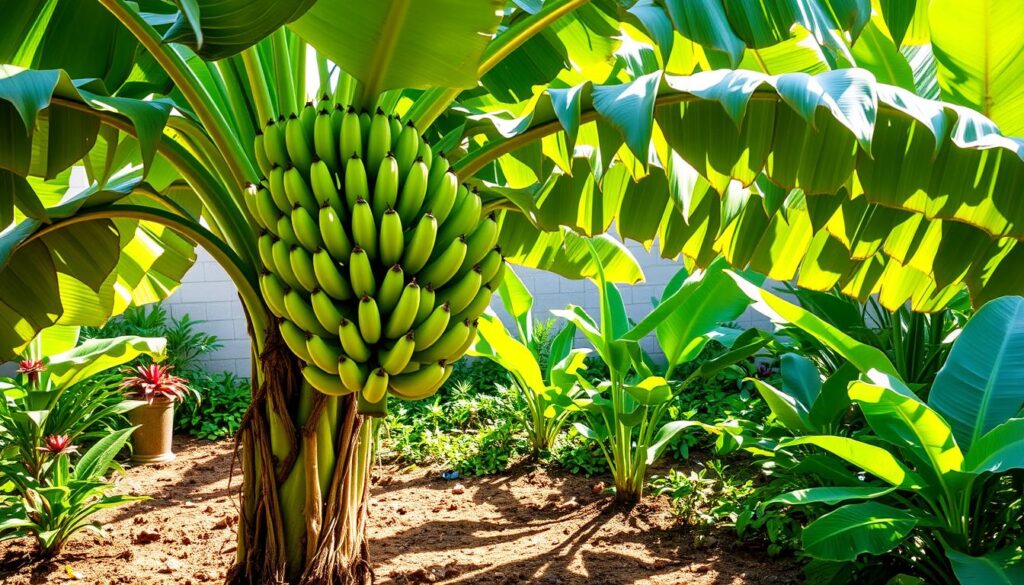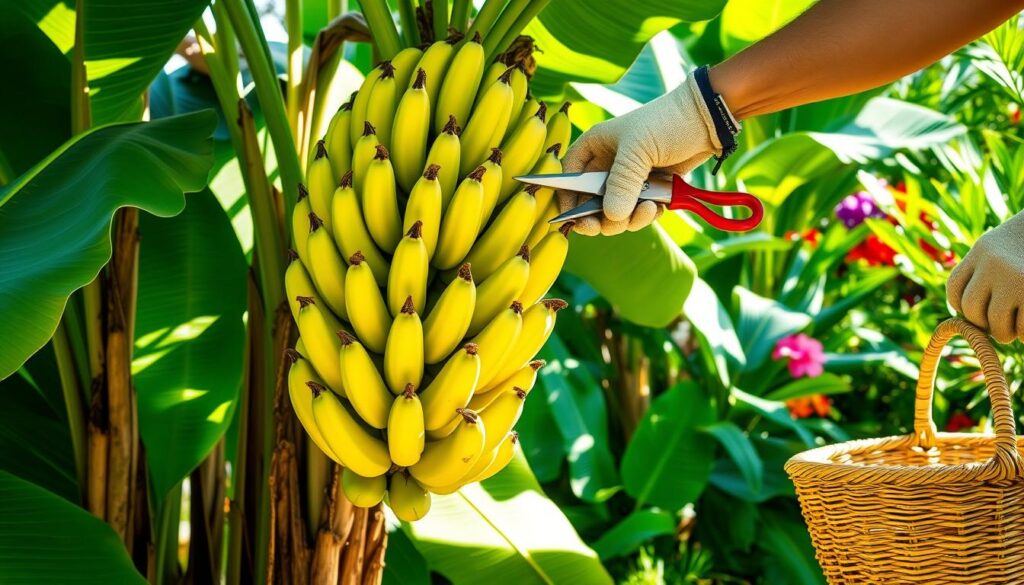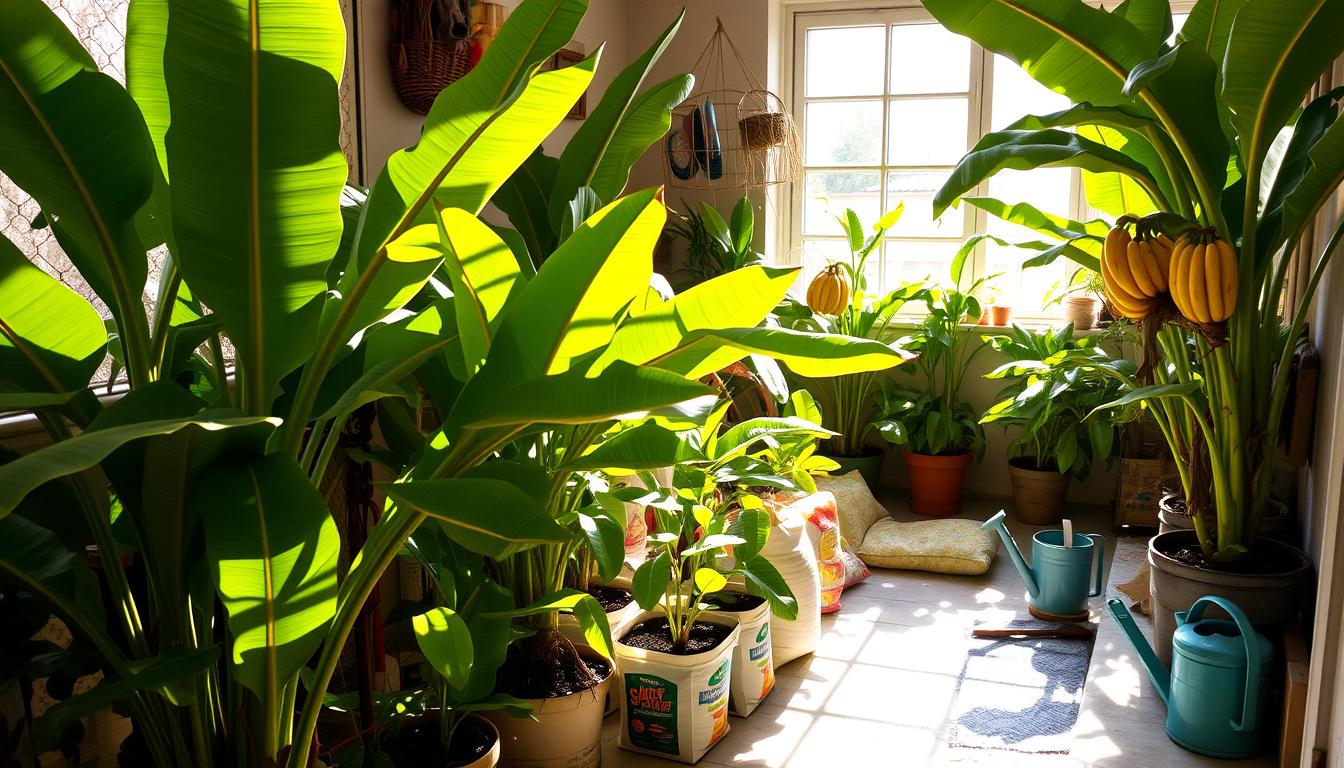Welcome to my guide on growing bananas at home! This guide is for both experienced gardeners and beginners. It will teach you the basics of banana cultivation. You’ll learn about the best climate, how to choose the right materials, and how to care for your banana tree.
Bananas are a tasty and rewarding fruit to grow. Most bananas in stores are Cavendish, a seedless variety with a rich history. Growing bananas indoors or in your garden can be very fulfilling. You’ll enjoy these tropical fruits right from your home.
In this guide, I’ll share important tips for growing bananas. You’ll learn about the right humidity level and soil drainage. I’ll make sure you have all the knowledge to grow healthy banana plants.
Key Takeaways
- This guide will cover all aspects of growing bananas at home.
- Understanding climate requirements, including temperature and humidity, is essential.
- Choosing the right location is crucial for successful banana cultivation.
- Learn about the differences between growing bananas from seeds and rhizomes.
- Regular care, including watering and fertilizing, is vital for plant health.
- Harvesting techniques will ensure you enjoy your bananas at their best.
- Be prepared for common challenges such as weather extremes and plant diseases.
Introduction to Banana Cultivation
Banana cultivation is a fun way to add a tropical feel to your garden. Learning how to grow bananas at home is key for those who want to enjoy this tasty fruit. The common banana, part of the Musa spp. genus, can grow up to 30 feet tall. They prefer USDA Zones 9-11, need full sunlight, and warm temperatures between 79°F and 86°F.
Banana plants do best with at least eight hours of sunlight each day. They can produce fruit on each stem before it dies, living for about six years. Bananas were first domesticated in Southeast Asia around 8000 BCE. Today, the Cavendish variety is the most popular, known for its great taste and versatility in recipes.
To grow bananas successfully, keep the soil pH between 6.0 and 7.5. They also need the right amount of water. My tips include watching how much water they get, as they need 4 to 10 inches per month. Avoiding too much water is important. Knowing their needs can help you get a good harvest.
| Factor | Details |
|---|---|
| Height | 2-30 feet tall |
| Width | 1-15 feet wide |
| Optimal Zone | 9-11 |
| Sunlight Requirement | Minimum of 8 hours daily |
| Temperature Range | 79°F to 86°F |
| Soil pH | 6.0 to 7.5 |
| Water Needs | 4-10 inches per month |
| Plant Lifespan | 6 years |
Understanding Ideal Climate for Growing Bananas
To grow bananas well, you need the right environment. This means managing temperature and humidity. Good banana tree care is more than just water and food. It’s about creating a stable climate for growth.
Temperature Requirements
Bananas love warm weather, best between 26–30ºC (78–86ºF) during the day. At night, they should stay above 20ºC (67ºF). Temperatures too low or high can slow growth.
Extreme temperatures are bad. Frost can kill them. So, places with cold snaps need careful handling. Bananas also need at least 12 hours of sunlight a day. For more on the ideal climate for growing bananas, check out this link.
Humidity Levels
High humidity is key for banana plants, needing at least 50% humidity. Keeping humidity steady helps plants grow and produce fruit. The right humidity and temperature make bananas thrive. Always check these conditions to give your plants the banana tree care they need.
Choosing the Right Location
Choosing the right spot for bananas is key for their growth and fruit. It’s not just about finding a sunny spot. You also need to think about the soil’s drainage. Knowing these things helps you get a better harvest.
Finding the Sunniest Spot
Banana plants love direct sunlight, needing 6 to 8 hours a day. I always pick the sunniest part of my yard for them. This ensures they get enough light for strong growth.
Being in bright sunlight helps them grow fast. This means you can enjoy their fruit sooner, usually in 10 to 15 months.
Ensuring Good Drainage
Bananas need lots of water, about 1 to 1.5 inches a week. But, they can get root rot if the soil doesn’t drain well. To check drainage, I dig a 1-foot hole, fill it with water, and see how fast it drains.
Good drainage should take 7-15 cm per hour. If it’s slow, I might use raised beds or add perlite to the soil. This is crucial for banana trees to thrive.
How to Grow Bananas at Home: Step-by-Step Guide
Growing bananas at home is rewarding. It brings fresh fruit and a tropical feel. To succeed, focus on the details. This guide covers key steps, like choosing the right planting material and preparing the soil.
Selecting Planting Material
The right planting material is crucial for healthy banana plants. For beginners, banana suckers or rhizomes are great choices. Look for suckers that are 6 to 7 feet tall with thin leaves.
When picking suckers, make sure to get a good chunk of roots. This helps the plant grow well.
Preparing the Soil
Soil quality is key for banana plants. It should be loose, rich, and drain well. The pH should be between 5.5 and 7. Don’t use potting soil; a cactus mix works better.
When planting, leave space at the top for water to drain. Fertilize regularly and add organic matter to improve soil. This helps your plants grow strong.
| Planting Material | Characteristics | Benefits |
|---|---|---|
| Banana Suckers | 6-7 ft tall, thin leaves | High yield, easier to transplant |
| Rhizomes | Underground stems | Stable growth, less prone to disease |
| Tissue Cultures | Laboratory-grown plants | Genetic uniformity, high yield potential |
Choosing the right planting material and preparing the soil are crucial. These steps help your banana plants thrive in your garden.
Planting Your Banana Plants
Planting banana plants needs careful attention and specific techniques. Knowing how to dig the right hole and use effective planting methods is key for healthy growth.
Digging the Proper Hole
I start by digging a circular hole that’s at least 1 foot wide and 1 foot deep. This size fits the root system well. A bigger hole can give more support to the plants. If I’m using containers, the hole size is the same for the best conditions.
It’s crucial to ensure the soil drains well. This keeps the plants healthy.
Planting Techniques
After digging the hole, I put the banana plant in it upright. The roots should be covered, but the base should be a bit exposed. I gently press the soil around the plant to make it stable.
I make sure not to pack the soil too hard. This can slow down the plant’s growth. By following these steps, I create a strong base for my banana plants.
| Element | Description |
|---|---|
| Hole Size | 1 ft wide, 1 ft deep; larger for more support |
| Container Size | At least 15 gallons with drainage holes |
| Plant Spacing | 8-10 feet apart for growth and airflow |
| Sunlight Requirements | 6-8 hours of direct sunlight daily |
| Fertilization Frequency | Every 4-6 weeks during growing season |
Essential Care Tips for Banana Trees
Proper banana tree care means knowing how to water and fertilize them. Both steps are key to keeping banana plants healthy and productive.
Watering Requirements
Banana plants love moist soil, especially when they’re growing. You’ll need to water them every day in hot weather. Make sure the top 1 to 3 centimeters of soil stays damp.
But, don’t overwater. Too much water can cause root rot. Adjust your watering based on your area’s climate and the banana tree type.
Fertilizing Your Banana Plant
Fertilize banana plants with a balanced fertilizer to help them grow. Feed them once a month. For new plants, start with 0.25 to 0.5 pounds of NPK 8-10-8.
As they get bigger, you can use 1.5 to 2 pounds of fertilizer. This ensures they get all the nutrients they need. Fertilizing helps them grow strong and produce more fruit.

Good watering and fertilizing practices are crucial for your banana plants’ health. Follow good watering practices and fertilize regularly for vibrant, productive banana trees.
Indoor vs. Outdoor Growing Conditions
Growing bananas indoors is a great option when outdoor conditions are not right. To grow bananas indoors, you need to create a space that feels like outside. This means lots of light, warmth, and humidity.
How to Grow Bananas Indoors
First, pick a dwarf banana variety for indoor growing. Dwarf Cavendish or Dwarf Red are good choices. They grow 6 to 10 feet tall and fit well in small spaces. Here are some tips for growing bananas indoors:
- Light: Make sure your banana plant gets 12 hours of bright light every day. It needs full sun to grow well.
- Temperature: Keep the temperature between 67°F and 90°F. The best temperature for growth is 80°F to 95°F.
- Humidity: High humidity is key. Try to keep it above 50% to help your banana plant grow.
- Watering: Keep the soil moist but make sure it drains well to avoid waterlogging.
- Fertilizing: Use balanced fertilizer once a month to help your banana plant grow strong.
- Repotting: Repot every three years to give your banana plant room to grow.
Here’s a quick look at some common indoor banana varieties:
| Banana Variety | Height | Notes |
|---|---|---|
| Dwarf Cavendish | 8-10 feet | Popular for indoor growing; decorative and potentially fruit-bearing. |
| Dwarf Red | 6 feet | Ornamental value with unique coloration; requires warm conditions. |
| Lady Finger | Varies | Small, sweet bananas ideal for containers. |
By focusing on these indoor growing conditions, you can turn your home into a lush, tropical space. This is where bananas thrive.
Monitoring and Maintaining Plant Health
Keeping banana plants healthy means checking them often and taking action when needed. This helps them grow well in your garden. It’s important to watch for pests and make sure they get the right nutrients.
Pest Control Strategies
Checking my banana plants regularly helps me spot pests early. Pests like aphids and banana weevils can spread fast. I use natural pest control, like neem oil, to keep them away.
By treating both roots and leaves quickly, I protect my plants. This also helps them grow strong and healthy.
Identifying Nutritional Deficiencies
Banana plants show signs when they need more nutrients, like nitrogen and potassium. If leaves are small or pale, or if they turn yellow, it’s time to act. I use special fertilizers for banana trees every 2-4 weeks.
Watching my banana plants closely helps them stay healthy and grow well. By controlling pests and giving them the right food, my garden stays vibrant.
For more tips on keeping your banana plants healthy, check out this useful resource.
Banana Harvesting Tips
Harvesting bananas needs careful attention for the best fruit quality. Knowing when and how to handle bananas greatly affects your harvest. Here are key tips for harvesting bananas.
When to Harvest Bananas
Bananas take 15 to 18 months to grow, depending on the variety and conditions. Harvest bananas when they are well-rounded and the flower at the end is dry. They should be green, about four to six weeks after growth stops.
It’s important to pick bananas quickly. Ripe bananas left on the plant attract animals. In fact, 100% of ripe bananas were eaten before I could pick them.
How to Properly Handle Harvested Bananas
A sharp knife is needed to cut bananas without damage. Having a second person helps during harvesting. One person cuts the stalk, and the other catches the bunch.
A bunch can weigh 40 to 60 pounds, which is heavy. If not caught right, damage or injuries can happen. Always handle bananas gently and store them in a cool, dry place to ripen.

Common Challenges in Banana Cultivation
Growing bananas has its own set of challenges. Knowing these can help ensure a good harvest. Weather extremes and diseases are major concerns that can harm banana plants.
Dealing with Weather Extremes
Bananas are very sensitive to weather changes. High or low temperatures and strong winds can hurt the plants. For example, temperatures above 86°F (30°C) or below 59°F (15°C) can slow growth. Winds can also damage the plants physically.
To keep banana plants safe, I use windbreaks and mulch. These help keep the soil moist and provide a stable place for growth.
Addressing Plant Diseases
It’s crucial to fight banana plant diseases to keep crops healthy. Problems like Panama disease and black leaf streak can spread fast and be very harmful. Watching the plants closely helps catch diseases early.
If I see disease signs, I treat my plants quickly with fungicides or natural remedies. This helps control the disease and keeps my banana plants healthy.
Conclusion
Growing bananas at home is a rewarding journey. It requires patience and the right knowledge. This guide has covered key points, from choosing the right climate to understanding different banana varieties.
By following the techniques in this guide, anyone can grow their own bananas. This can be done indoors or in an outdoor garden.
The journey to growing bananas can take nine months to a year. But the wait is worth it for the taste of homegrown bananas. Proper care, like watering and fertilizing, is crucial for a successful harvest.
With careful attention, you can enjoy a bountiful harvest. These fruits are not only delicious but also nutritious.
If you’re interested in growing bananas, a Contact page can offer valuable resources. As I conclude this guide, I’m excited about the potential for vibrant, fruitful plants. They will bring joy to my home.



Leave a Reply